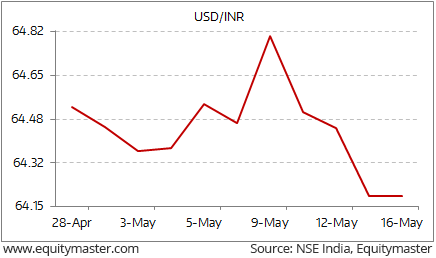Investment in securities market are subject to market risks. Read all the related documents carefully before investing
Grab Our Small Cap Recommendation
Service at a 60% Discount
- Home
- Todays Market
- Indian Stock Market News May 17, 2017
Indian Indices Remain Flat; Consumer Durables Stocks Witness Selling Wed, 17 May 01:30 pm
Indian share markets are presently trading marginally higher. Sectoral indices are trading on a mixed note with stocks in the metal sector and power sector leading the gains. consumer durables stocks and IT stocks are trading in the red.
The BSE Sensex is trading up 33 points (up 0.1%), while the NSE Nifty is trading flat. The BSE Mid Cap index is trading up by 0.1%, while the BSE Small Cap index is trading down by 0.1%.
In the news from currency markets... The rupee is witnessing buying interest against the dollar today. Presently, it is trading at 64.09 to the US$.
One must note that the rupee is witnessing buying interest of late. It presently is hovering near its 20-month high.
Dollar Continues Downtrend

The rupee has gained 6% so far this year. Most of these gains came as the dollar fell on the back of political turmoil surrounding US President Donald Trump.
On must note that the appreciation in the rupee comes as a welcome breather for importers in India. A softer rupee helps importers to buy goods and services at a cheaper rate that earlier. This is vital for a developing economy that relies heavily on imports. This bodes well for the Indian economy as higher imports normally mean increased economic activity.
But on the other hand, the rise in rupee can spell trouble for exporters. The exporters are at a disadvantage owing to the currency appreciation as this renders their produce expensive in the international markets as compared to other competing nations whose currencies haven't appreciated on a similar scale. This tends to take away a part of the advantage from Indian companies, which they enjoy due to their cost competitiveness.
Nonetheless, a stronger rupee will pull down commodity prices. This will help in keeping a tab on the rising inflation.
While there are advantages as well as disadvantages of a rising rupee, one needs to understand whether the rise in the rupee is sustainable to derive any reasonable conclusion at this stage.
For one, the weakness of the US dollar is largely due to the relative unattractiveness of US assets. This is in part due to a very low interest rate regime prevalent in the US economy. Already there are indications that this low interest rate regime may not be sustainable for long. This means that US interest rates may go up and this may likely strengthen the US dollar.
To keep a tab on the movements in rupee-dollar and other currencies, you can read the stock market commentary from the Daily Profit Hunter team. Their commentary tracks the developments in the global economy as well as stock, currency and commodity markets.
In other news, India Ratings and Research (Ind-Ra) in its latest report has said that the policy which is betting on higher spending on infrastructure and construction sector will give a boost to the struggling Indian steel industry cautioning that execution of provisions in the new steel policy will remain a key challenge for the government.
Though the execution of provisions in the policy will remain a key challenge for the government and therefore to make the policy successful, timely implementation of various steps will be crucial along with ways to build demand leading to improvement in capacity utilisations of existing plants.
The report further said that steel demand should grow at a CAGR of around 7 -7.5% during the period against a CAGR of 3.5-4% over the last 5 year to meet the expected demand of 230 MT and to increase the steel capacity to 300 MT by 2030-31 would require extensive efforts towards increasing the availability of resources such as infrastructure, raw material and finance.
While accelerated spending by government in infrastructure, construction, railways and the defence sector will be the key to achieve the aggressive demand growth, Ind-Ra believes the expected growth in steel demand looks ambitious and may face hurdles like political instability, budget constraint and timely execution of projects.
However, it has said that the capacity creation which requires capital expenditure of around Rs 10 trillion will lead to stretched credit metrics on a sustained basis for companies, due to the continuous capex undertaken, and expects that central public sector enterprises will be under pressure to build capacity for catering to any demand- supply gap after considering the capex by the private sector.
For information on how to pick stocks that have the potential to deliver big returns, download our special report now!
Read the latest Market Commentary


Equitymaster requests your view! Post a comment on "Indian Indices Remain Flat; Consumer Durables Stocks Witness Selling". Click here!
Comments are moderated by Equitymaster, in accordance with the Terms of Use, and may not appear
on this article until they have been reviewed and deemed appropriate for posting.
In the meantime, you may want to share this article with your friends!